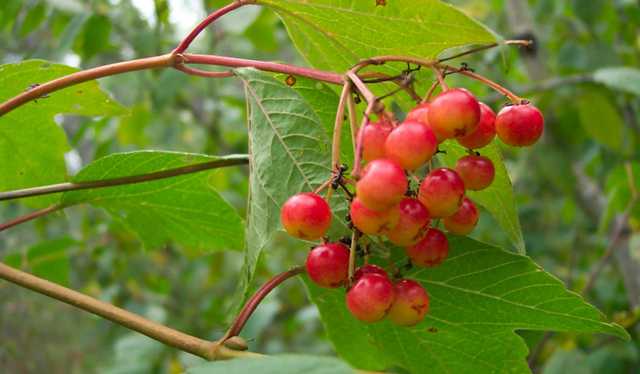Highbush Cranberry Production in Manitoba
Description

Highbush cranberry (Viburnam trilobum Marsh.) is sometimes confused with the true cranberry (Vaccinium macrocarpon). Highbush Cranberry is a deciduous shrub belonging to the Caprifoliaceae family with an open spreading habit and a height ranging from 6.5 to 13 ft (2 to 4 m). Highbush cranberries are native to Canada with a range from New Brunswick to British Columbia and North to Alaska making it very winter hardy. Highbush Cranberry has not received a lot of attention from breeders but there are some cultivars available with improved fruit characteristics.
Highbush cranberry flowers in early summer and produces fruit ripe by late summer. Often the fruit is picked after a frost which tends to make the fruit more palatable.
Uses
Highbush cranberries are well known for the sparkling jelly produced from the fruit. The fruit is also used to make wines, liqueurs, and sauces. The fruit of the highbush cranberry is said to smell like "dirty feet," this is normal and disappears during the cooking process. The addition of lemon or orange peelings during cooking will help to eliminate the natural odour.
Site Selection/ Spacing/Rooting Depth
The native habitat of the highbush cranberry is shady, moist places such as stream banks, wet thickets, and old river bottoms. For planting in orchard conditions, the soil should be a well-drained loam or silt loam with good moisture holding capacity and a pH of 6.0 to 7.5. Highbush cranberries are not drought resistant and severe injury or death may occur under extended drought periods. Plant spacing should be 6.5 to 8 ft (2 to 2.5 m) between plants and 13 and 20 ft (4 to 6 m) between rows.
Highbush cranberry does not have a very deep rooting depth or spread.
Harvesting/Nutritional Value
It takes several years after planting before fruit development occurs. Full production should be anticipated by the fourth or fifth year. The fruit should be harvested when under-ripe to maintain a high pectin level especially when being used to make jelly. The fruit is hard, crisp, and sour before ripening but becomes soft, palatable and lower in pectin after a frost. The nutritional value of highbush cranberries has not yet been determined.
